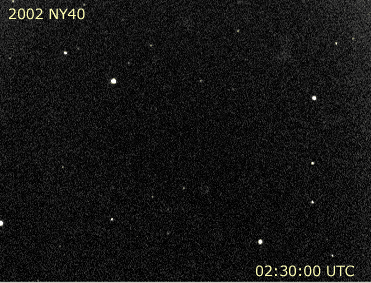Image of the Month - September 2002
Asteroid 2002 NY40 in Motion
Asteroid 2002 NY40 passed only only 0.00352 A.U. (about 527'000 km or 327'000 miles - that is about 40% more
distant than the Moon) from Earth on August 18, 2002, about one month after it was discovered by the
LINEAR asteroid survey. It is the brightest (and therefore, probably the
largest) minor planet known to come that close to our home planet. During the flyby, it was so bright that it was an
easy target for small telescopes and even binoculars.
While the rapid motion, peaking at nearly 490 arc seconds per minute, made it easy for visual observers to distinguish
the space rock from field stars, it made it difficult for observers using CCDs who wanted to capture untrailed images
of the asteroid.

Credit & Copyright: André Knöfel
and Thomas Payer,
Walter-Hohmann Observatory, Essen, Germany
Asteroid 2002 NY40, imaged on August 18, 2002, by André Knöfel and Thomas Payer,
Walter-Hohmann Observatory, Essen,
Germany. Payer combined five images, sapnning 2 minutes and 20 seconds, to create this animation.
Each exposure, taken with a 0.32m Newtonian reflector and a SBIG ST-6 CCD, was only 0.5 seconds,
to prevent the fast moving asteroid from trailing.
Related Links:
Longer Animation by Valentino Pozzoli, J.B. Postel Observatory, Italy: Available as 800 kB AVI or 2.8 MB GIF
2002 NY40 Object Homepage (NEODys)
2002 NY40 Orbit Animation (JPL)
Closest Approaches by Minor Planets (MPC)
Image of the Month
Previous | Archive | Next
[ Home |
Downloads |
Version History |
Star Catalogs |
Registration |
Mailing List |
About the Author |
Minor Planets |
Monthly Image |
Papers |
Links ]
